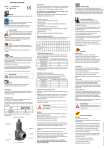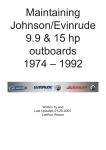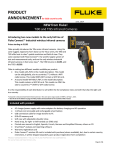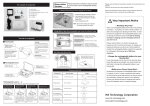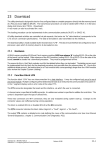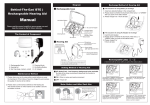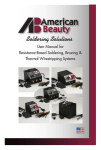Download Flanged 2600
Transcript
Broady Flow Control Limited, English Street, Kingston upon Hull, East Yorkshire, HU3 2DU. www.broady.co.uk Telephone: 01482 619600 Facsimile: 01482 619700 SERVICE MANUAL Series 2500/F Safety Relief Valve (Screwed) SD23/250F-GA1 10/01 Series 2500/F Safety Relief Valve 1. OPERATION Safety Relief valves are automatic discharge valves and have the function of maintaining the pressure in a circuit below a set limit. A Safety Relief valve consists of three main parts: Nozzle Disc Spring - Which permits the discharge medium to be piped away correctly. Which closes the Nozzle discharge orifice. Which opposes the force of the medium below the Disc. When the force exerted by the pressure of the medium on the disc exceeds the spring force, the disc begins to lift. The pressure exerted by the discharge medium on the surface of the ring shaped chamber of the disc holder produces immediate opening of the valve. The distance of the blowdown ring relative to the disc holder has an effect on the change in the pressure between opening and closing for valves used with gases and vapours. For valves used with liquids, the blowdown ring must be lowered in such a way as to make it ineffectual. 2. INSTALLATION During mounting the Valve: - Avoid bumping or shaking the Valve to prevent damaging the flange faces and misalignment of the trim. - Blow through the circuit line on which the Valve is to be installed to remove any foreign matter (welding chips etc.) - Clean thoroughly the Valve and Nozzle connections: impurities on the Nozzle may damage the Valve Seat during popping. - Install the Valve in the vertical position only with the inlet downwards. - Tighten uniformly the bolts of the flanges connecting the Valve to the pipework. - Use inlet and outlet pipework as short as possible and of dimensions equal to the valve connections. - Avoid strain on the outlet flange, with suitable supports. - Secure the outlet pipework in order to reduce vibration and to avoid strain on the outlet flange. - Avoid elbows with small curvature radius on the outlet pipe: for high temperature gas and vapour discharge, use expansion joints. After the Valve has been installed make it pop at least twice to allow automatic alignment of the trim. Misalignment may be caused accidentally during transport or during installation of the Valve. 2 Series 2500/F Safety Relief Valve 3. TESTS The valves are factory tested before consignment, according to the Customer’s required specifications detailed in their order. It is nevertheless recommended that the following tests be carried out before installation of the valve. 3.1 Disc seal For this operation it is necessary to. - Connect the valve inlet to a container (fig 1) in which the pressure may be raised gradually and measured by the means of a pressure gauge. Close the valve with a plate, in the centre of which a tube is inserted which is immersed in a container of water. The seal test consists of raising the inlet up to 90% of the set pressure and checking that the number of air bubbles per minute which pass through the container do not exceed the values shown in the Valve Testing Data table (page 5). Should the leakage exceed the values given in the testing data table, then consult the table “FAULTS IN OPERATION” on page 7 3.2 Set pressure For this operation it is necessary to connect the valve inlet to a container in which the pressure may be raised gradually and measured by means of a pressure gauge. The test consists of checking that the valve starts opening at the required set pressure (refer to Valve Testing Data table) Changes outside the stated tolerances must be corrected by varying the spring compression, by means of the spring adjusting screw. To regulate the set pressure (see fig 1). (1) (2) (3) (4) (5) (6) Place the valve on the tests stand (fig 1) with no pressure on the valve inlet. Remove the cap (3) Prevent the disc-holder rotating by means of holding the spindle (5) with a screwdriver inserted into the slot at the end. Loosen lock nut (14) of the adjusting screw (13) Regulate the spring adjusting screw until the desired set pressure is reached. Do not allow the disc holder to rotate. Reassemble the cap (3) NOTE: For each successive set pressure check; the lock nut must be tightened. 3 Series 2500/F Safety Relief Valve 4 Series 2500/F Safety Relief Valve Tag Number Valve Set at Cold Set Seat Tightness VALVE TESTING DATA Refer to Name Plate on Valve Refer to Name Plate on Valve Refer to Name Plate on Valve 40 Bubbles / min at 90% of the set pressure 4. OVERHAUL Overhaul of the Valve means dismantling it completely to clean every part thoroughly and to decide whether the various parts may be re-used, adjusted or substituted. It is necessary to check that the contact surfaces of the seat and disc area are in perfect condition. Should scratching or pitting be present the surfaces must be ground and then lapped. 4.1 Lapping the Disc Use a cast iron block with a perfectly smooth and flat surface, or a plate glass block of a suitable size. For a perfect lap pass the disc across the smooth surface of the block, after applying a small quantity of lapping compound, using a figure of eight movement. Lift the disc periodically away from the block so that the compound may flow from the edges towards the centre. 4.2 Lapping the Nozzle Seat Use a cast iron or plate glass block as for lapping the disc, and check that this does not tilt to avoid rounding off the edges. After spreading the lapping compound over the smooth surface of the block, pass the Nozzle seating surface over the block using a figure of eight movement. During the lapping operation, make sure that there is no foreign matter on the lapped surface or on the block. The lapped parts must be carefully cleaned before assembling, so as to remove every trace of lapping compound. 5. NORMAL MAINTENANCE The most frequent operation to be carried out is a precise check, made at regular intervals, to observe whether any obvious faults exist in the different parts of the Valve. It should be checked first of all that there are no leakage’s; these must always avoided, especially when the medium is poisonous, highly volatile or very explosive. Carry out periodic venting for Valves fitted with lifting devices to check regular operation (at least two or three times a year). During these tests the pressure must be at least 75% of the full working pressure. 5 Series 2500/F Safety Relief Valve 6. DISASSEMBLY (1) (2) (3) (4) (5) (6) (7) (8) (9) Remove Cap & Joint (3 & 32). Measure position of the Adjusting screw (13) and record for re-assembly purposes. Slacken Locknut (14) and unscrew Adjusting screw (13). Remove Clampscrew (16). Unscrew Nozzle (2), and lift off Body (1) and Joint (31). Lift off the Spindle/Valve Lid assembly (parts 4, 5, 7, 9, 11 & 35). Lift off the Spring Carriers (17) and Spring (29). Remove Disc (4) from the Disc Holder (7) by tapping Disc Holder firmly onto a clean wooden surface, care should be taken not to misplace the Circlip (35) and Ball (11). Unscrew Blowdown Ring (8) from Nozzle (2). 7. ASSEMBLY Reassemble the Valve carrying out the operations listed for disassembly in reverse and taking care to: Avoid scratching on the lapped surfaces of the Seat and Disc. Clean the trim thoroughly throughout. Spread with graphite grease all threads, the Adjusting Screw and the Spring Carrier. FOR VALVES FOR OXYGEN SERVICE, CAREFULLY DE-GREASE ALL PARTS BEFORE ASSEMBLY. Fit new gaskets. To prevent damage to Disc/Nozzle faces hold spindle with screwdriver in the slot on the end of Spindle turning whilst compressing Spring. 6 Series 2500/F Safety Relief Valve 8. FAULTS IN OPERATION FAULT CAUSES Leakage Discharge at incorrect pressure Chatter (rapid opening and closing cycle). SOLUTIONS (1) Presence of foreign matter between seat and disc (1) Discharge valve once or twice consecutively. Should leakage continue, disassemble valve and clean trim. (2) Scratching or pitting on seat surface (2) Disassemble valve, grind and lap seat. (3) Valve used with a medium other than specified when ordering (3) Lap seat and disc more finely if the valve originally ordered for liquid service, is used with gas (4) Valve not mounted vertically. (4) Correct installation. (1) Variable back pressure (1) Check that discharge takes place in piping whose dimensions are equal to or greater than those of the outlet connections of the valve, and that the discharge piping is free from obstruction. (2) Back pressures different from specified when ordered (2) The valve must be re-calibrated correcting the spring compression for the revised set pressure. (3) Loosening of lock nut on spring adjusting screw. (3) Tighten lock nut after re-calibrating the valve. (4) Poor trim alignment. (4) Discharge the valve 2 or 3 times to allow self-alignment of the trim. (1) Blowdown ring incorrectly adjusted. (1) Ensure that the blowdown ring is in the lowest position for liquid service. For valves used on gas; regulate suitably. (2) Insufficient discharge capacity. (2) Check that the discharge piping is not too long. Check that the valve is not undersized. 9. PARTS LIST ITEM 1 2 3 4 5 7 8 9 11 13 14 15 16 17 18 29 31 32 33 34 35 36 DESCRIPTION BODY NOZZLE CAP DISC SPINDLE DISC HOLDER BLOWDOWN RING PIN BALL ADJUSTING SCREW LOCKNUT (ADJUSTING SCREW) SCREWED PIN CLAMPSCREW SPRING CARRIER LOCKNUT (SCREWED PIN) SPRING JOINT (NOZZLE) JOINT (CAP) JOINT (CLAMPSCREW) JOINT (PLUG) CIRCLIP PLUG 7 QTY 1 1 1 1 1 1 1 1 1 1 1 1 1 2 1 1 1 1 1 1 1 1 Series 2500/F Safety Relief Valve Fig 2 Note - Valve illustrated shows Female Type Inlet (Part 2) this is also available with Male connections 8









